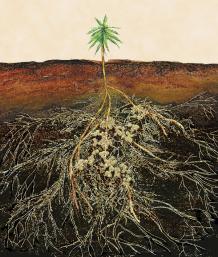Practical Mycorrhiza techniques
Mycorrhizal fungi increase the surface absorbing area of roots as much as 50 times, thereby greatly improving the ability of the plant to access soil resources. Several miles of fungal filaments can be present in less than a pinch of soil. Mycorrhizal fungi increase nutrient uptake not only by increasing the surface absorbing area of the roots, but also release powerful organic compounds into the soil that help to solubilize hard to access nutrients, such as organic nitrogen, phosphorus, iron and other tightly bound soil nutrients.
Since the relationship between plant and fungi evolved to help the plants access low levels of phosphorus in the soil, mycorrhizae do not grow and colonize roots when the phosphorus level is high. Phosphorus levels above 10 ppm in the soil solution will impact the growth and establishment of mycorrhizae. This does not kill the mycorrhizae, but creates an environment in which the mycorrhizae do not germinate and grow effectively.
Mycorrhizal associations DO form in.. (Refer to the bottom of the page for a comprehensive list)
Most green leafy plants, unless they are commercially produced.
Shrubs and foliage except for Rhododendron, Azalea, and Heath.
Berries, except for Blueberries, Cranberries and Lingonberries.
Nut trees, except Pecan, Hazelnuts and Filberts.
Most flowers
Vegetables except Brassica, and Beets.
Grasses, except weedy grasses
Fruit trees including tropical fruits,
Wetland/aquatic species, except rushes and horsetails
There are a few plant types that do not form any mycorrhizal association:
Brassica family (Broccoli, Brussel Sprouts, Cabbage, Cauliflower, Collards, Kale), Beets, Carnations/Dianthus, Mustard, Orchids, Protea, Rush, Sedge and Spinach.
Non-mycorrhizal plants require high levels of fertilization to maintain their health. Mycorrhizal fungi form an intricate web that captures and assimilates nutrients, conserving the nutrient capital in soils.
The mycorrhizal spores germinate in response to the release of sugars and hormones from the plant roots. This trigger allows the spores to stay dormant in a mix until plants are actively growing. Therefore, the shelf life of mycorrhizae is typically longer (up to two years) than other biological additives.
Typical lime rates and medium pH levels of professional growing medium products do not have a significant positive or negative effect on the growth and colonization of mycorrhizae.
Rootshield and Actino-Iron have been shown in independent research to be fully compatible with mycorrhizae in soilless mixes, so these are recommended. There are other helper bacteria or fungi that are often added to a mycorrhizal blend. They can stimulate and support the growth of the mycorrhizal colonies.
Most growing mixes contain inorganic-based fertilizers. Research has shown low levels of mycorrhizal colonies when a standard inorganic nutrient charge is used in the mix, which releases nutrients in a short time frame.
Excellent colonization occurs when mycorrhizae are added to mixes containing organic or controlled release fertilizers. Organic fertilizers release their nutrients slowly over time so the levels of phosphorus remain within a tolerable range for good mycorrhizal growth and colonization.
When using a mix supplemented with mycorrhizae, a fertility program with low levels of inorganic phosphorus should be employed. Any water soluble or controlled release fertilizer formulations should be low in phosphorus and delivered at a concentration or rate that result in 10-ppm phosphorus or less.
Tillage, removal of topsoil, erosion, site preparation, compaction, fumigation, invasion of weeds, and leaving soils fallow are some of the activities that can reduce or eliminate these beneficial soil fungi. Studies show that mycorrhizal populations are slow to recolonize naturally, therefore, reintroducing mycorrhizal fungi in areas where they have been lost or in artificial growing media can dramatically improve plant performance with less water and fertilizer and at a reduced cost.
